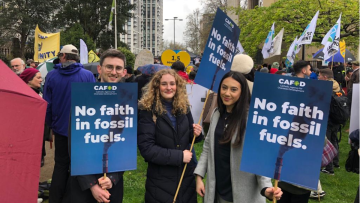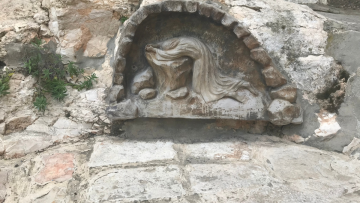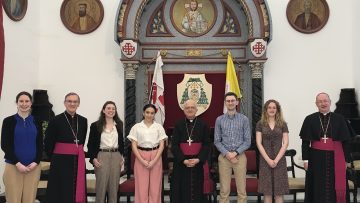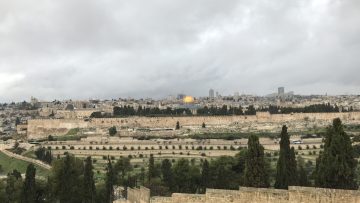Dear Diary: The Holy Land, Day 3

Bishop John Arnold shares snippets of his diary entries during his time in the Holy Land with the Faith in Politics interns. Today, we went to Bethlehem!
Day 3 – Wednesday 15th March
Our first stop was Bethlehem. We were together in a minibus and set off on the recognised route but along the way the driver was told by telephone that checkpoint 300 has been closed at short notice. The closure of check points can cause chaos to so many people who cannot get to work or school. Fortunately, our driver seemed to know a route Beit Jala that got us safely to Bethlehem.
Our first stop was the Basilica of St Catherine. Below the Basilica is a complex system of tunnels and one is named the Cave of St Jerome. It is believed that St Jerome came from Croatia to translate the Bible here. He lived in this cave for about thirty-six years, traveling locally to learn about local customs and ways of life to assist him in making an accurate translation. We celebrated Mass there.

The church is part of a complex which includes the Church of the Nativity. The group, being so small, was able to sidestep the enormous queues winding around the church for a quick visit to the place venerated as the place of the Nativity, which originally would have been in a cave rather than a stable. Our excellent guide, Michael, explained that Mary would have wanted some privacy for the birth and the cave/stable would have allowed that sense of privacy.
We walked from the Church of the Nativity to the Salesian Technical College where we met the Rector and Vice-Rector. They were so welcoming and explained the role of the school in training engineers and technicians for employment. They also ran a bakery which has always supplied bread free of charge to the poor. The amount distributed freely during the pandemic rose to 350 Kilos a day. We were shown the learning spaces where many young Bethlehemite Palestinians were in training and we visited the bakery, from which we purchased some very tasty bread!

The next stop was the Milk Grotto – a place where Mary is said to have stopped to feed Jesus at the start of the flight to Egypt. It is a place of pilgrimage, particularly for Christian and Muslim women who are hoping to get pregnant or who pray about matters of health.
We then visited St Martha’s House which is a day centre for elderly ladies, many of whom are widowed, providing care and community. About twelve of the ladies were there and they greeted us warmly.

But no time to delay. We next made a visit to the Shepherds’ Field. This is a place commemorating the appearance of the angels to the shepherds to tell them of the birth of Christ. A simple, modern chapel, with three paintings expressing the surprise of the shepherds at the appearance of the angels, the moment of their adoration of the child, and their rejoicing as they returned to their flocks.

Our last meeting of the day was with an ecumenical educational institute called Tantur. This is housed in a complex of buildings on the top of a hill between Bethlehem and Jerusalem. There were negotiations, following Vatican II, about the need to establish a place for ecumenical and interfaith dialogue and learning. Various Catholic universities were invited to found this place and eventually Notre Dame of U.S.A. took up the challenge. In religious terms, it is thought to have been the site where Mary and Joseph rested on their way from Jerusalem to Bethlehem. Today the college runs a series of courses which bring together Christians, Muslims and Jews for learning and dialogue. The Rector is a Melkite Christian and a Jesuit priest.
Much of the ninety-minute conversation was about the increasing difficulties endured by Palestinians in their movement across the Separation Wall, and the exodus of the young seeking better employment. But there is clearly a growing opposition among the Israelis about the behaviour of their current government and the proposed legislation about changes to the judiciary. Last weekend, it is estimated that 500,000 Israelis demonstrated in Tel Aviv. So, for the first time, there seems to be real dissent among the Israelis but whether or not that might include the promoting of human rights for the Palestinians remains to be seen.



